Abstract
The mechanical properties of left ventricular contraction were described in terms of tension, velocity, length, and time in closed-chest, sedated normal, hypothyroid, and hyperthyroid dogs. Heart rate was controlled at 150 beats/min, and instantaneous contractile element velocity was calculated from left ventricular pressure and its first derivative during isovolumic left ventricular contractions, produced by sudden balloon occlusion of the ascending aorta during diastole. Wall tension was derived from ventricular pressure and volume, the latter being obtained from the pressure-volume relation of the arrested ventricle, and tension-velocity relations were analyzed over a range of ventricular endiastolic volumes. At any level of ventricular volume, the hypothyroid state was associated with a displacement of the tension-velocity relation of the left ventricle downwards and to the left, and the time to peak tension was prolonged (154 msec, normal 139 msec). In the hyperthyroid state, the tension-velocity relation of the left ventricle was displaced upwards and to the right, and the time to peak tension was reduced (80 msec). The changes in the tension-velocity relations indicate that the inotropic state of the left ventricle in the intact dog varies directly with the animal's thyroid state. This influence on myocardial contractility necessarily constitutes an important and integral part of the response of the intact circulation to altered thyroid state.
Full text
PDF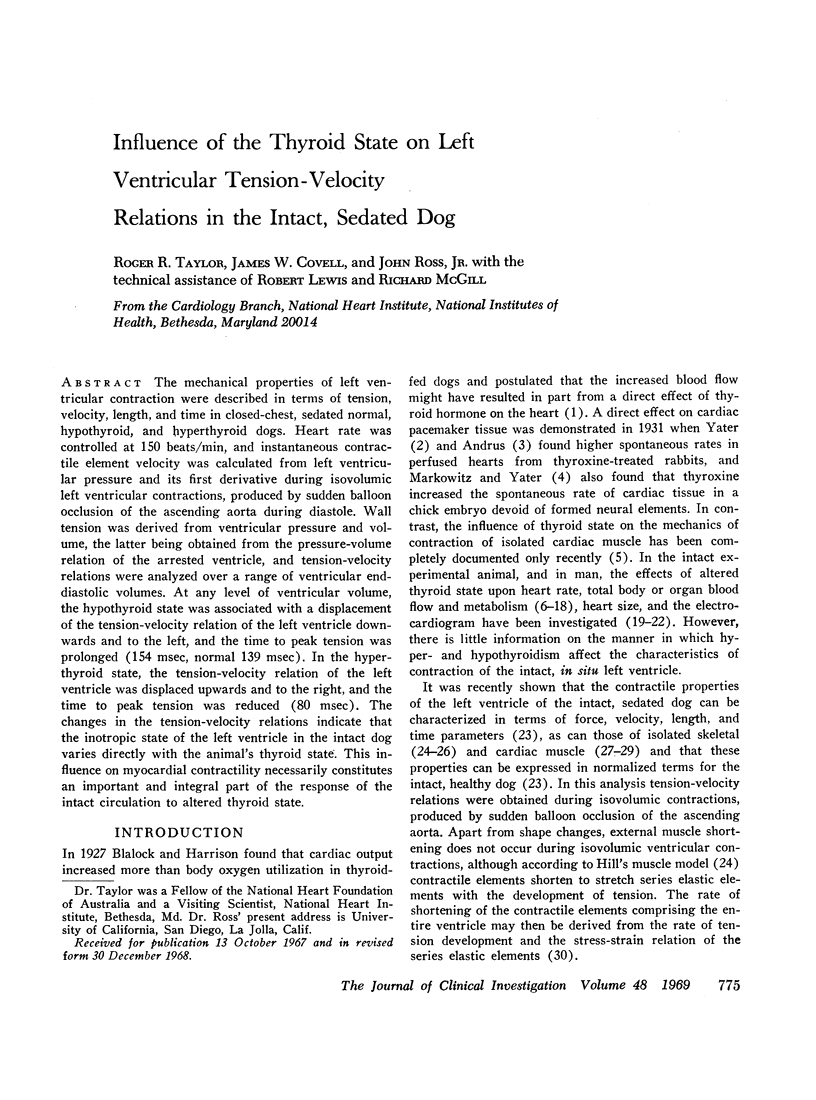
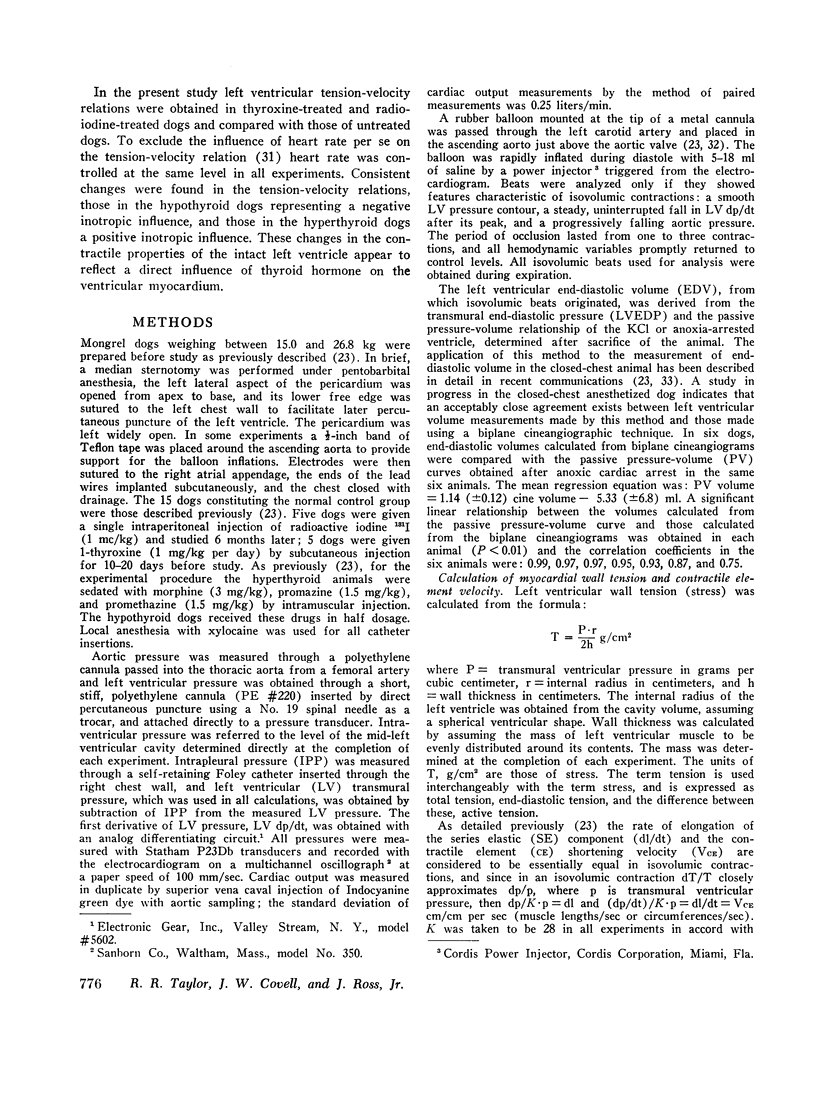
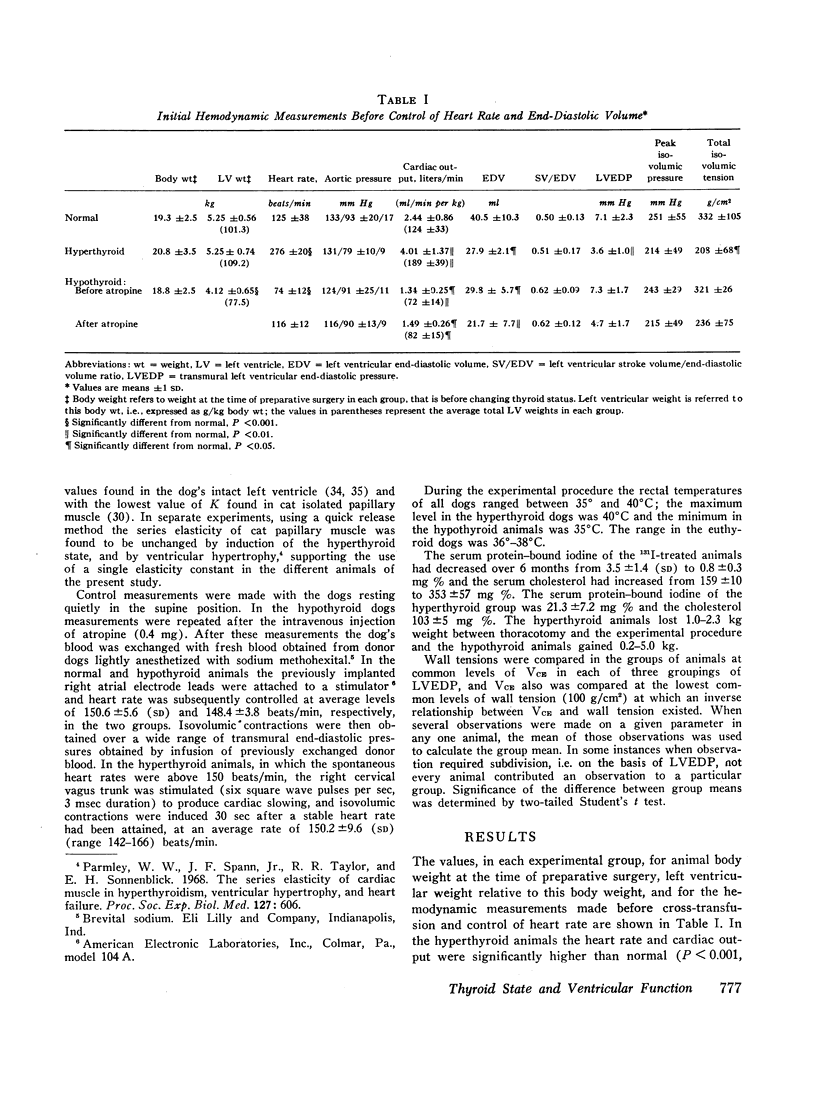
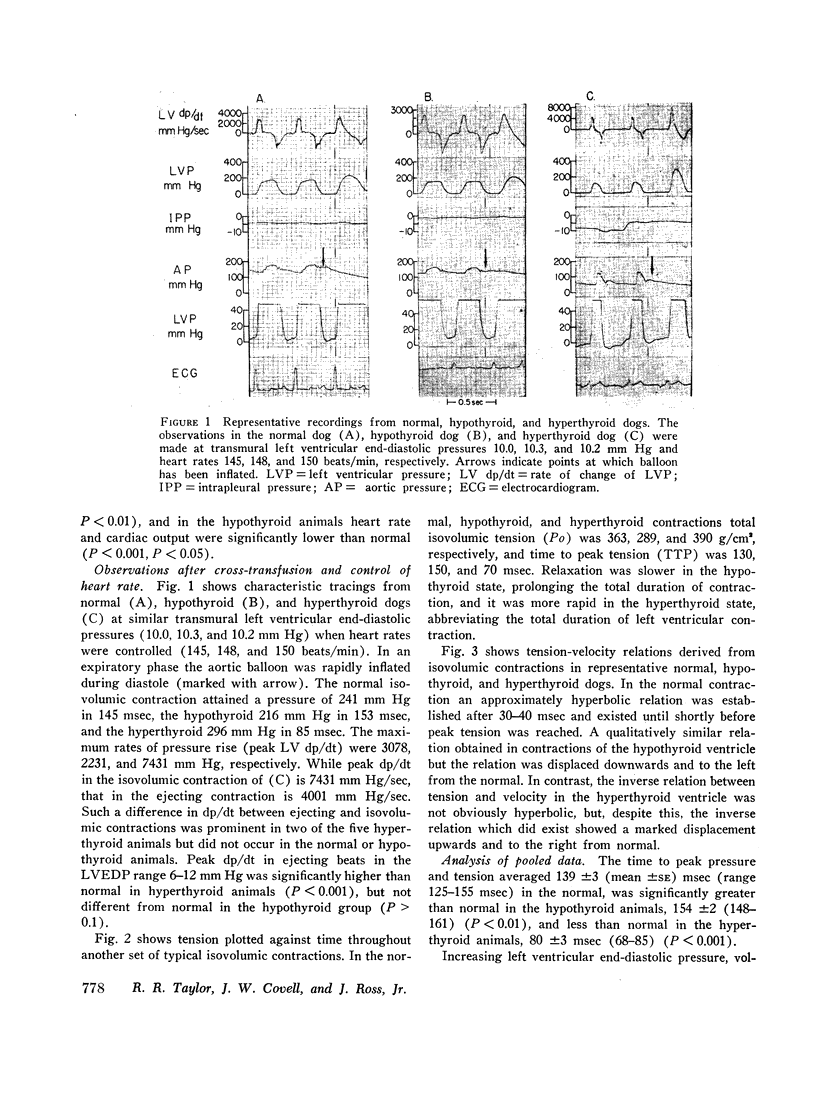
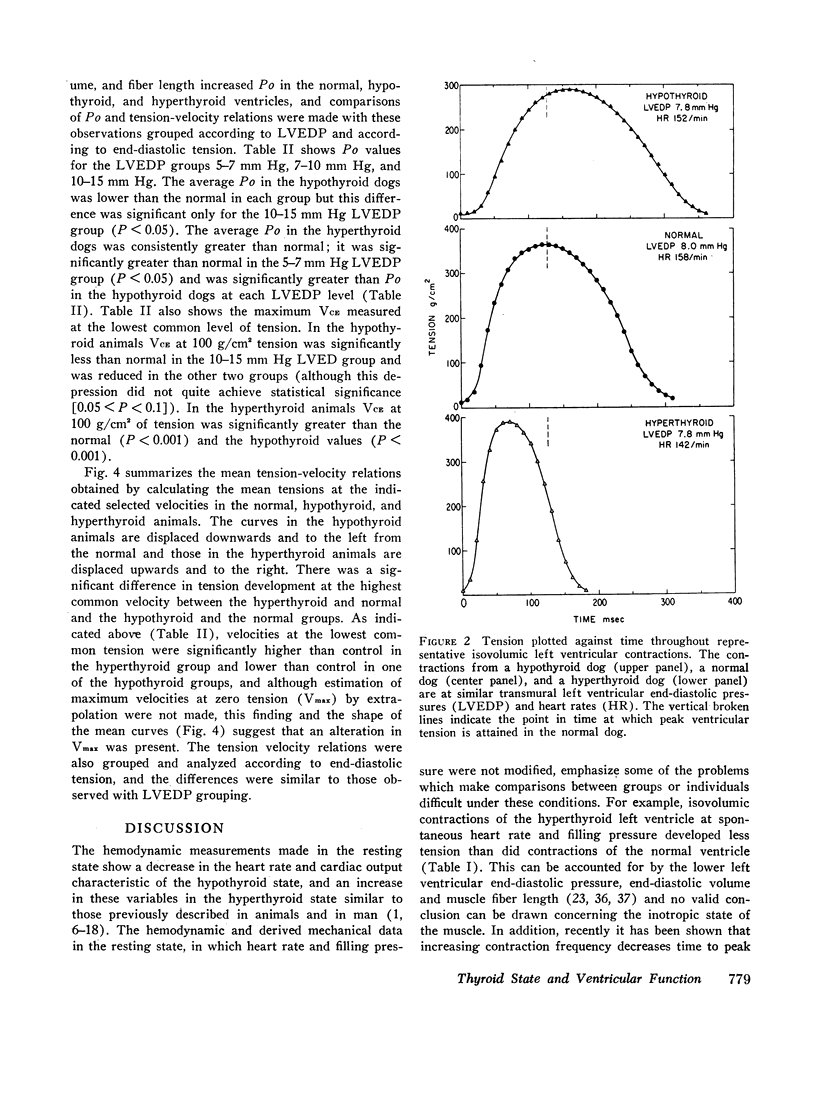
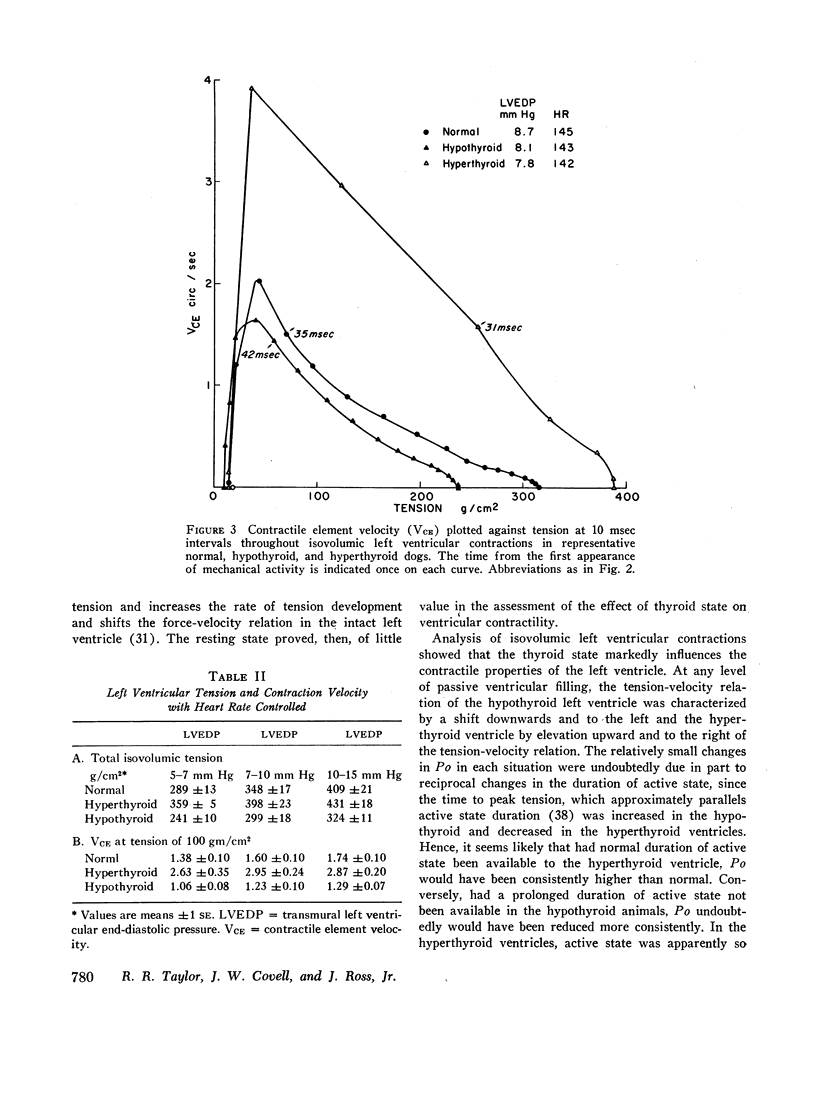
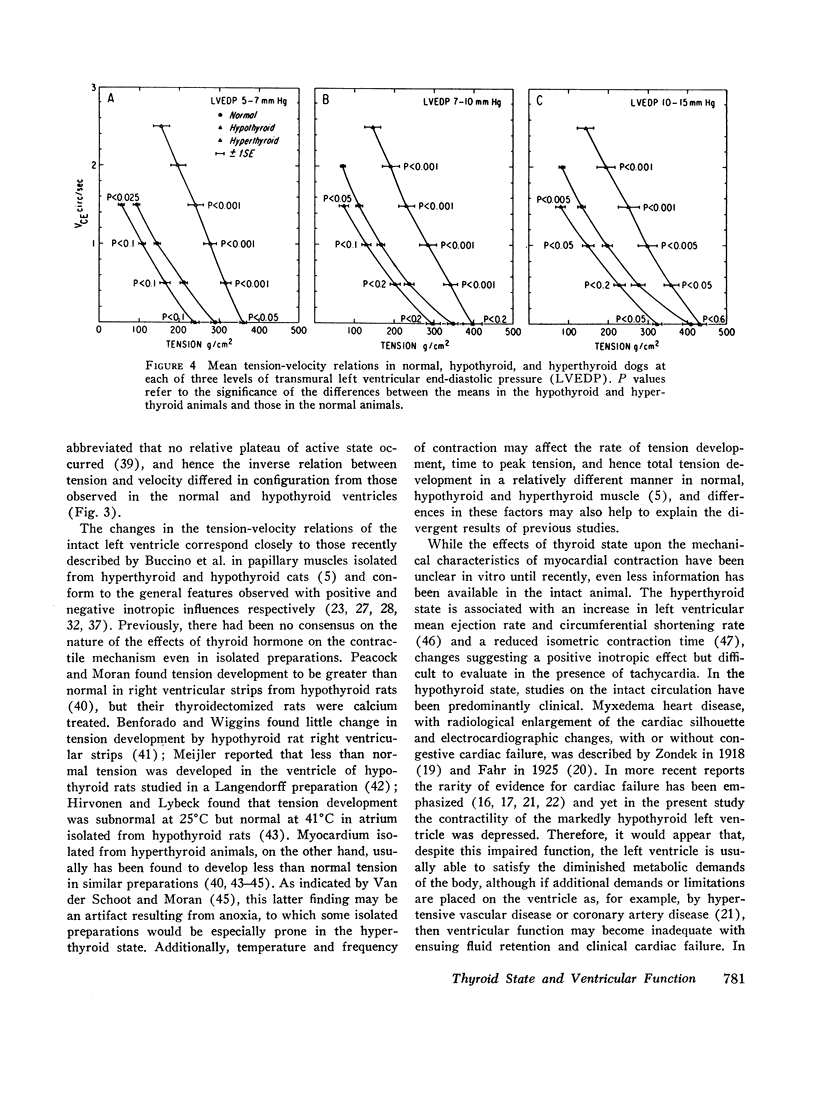
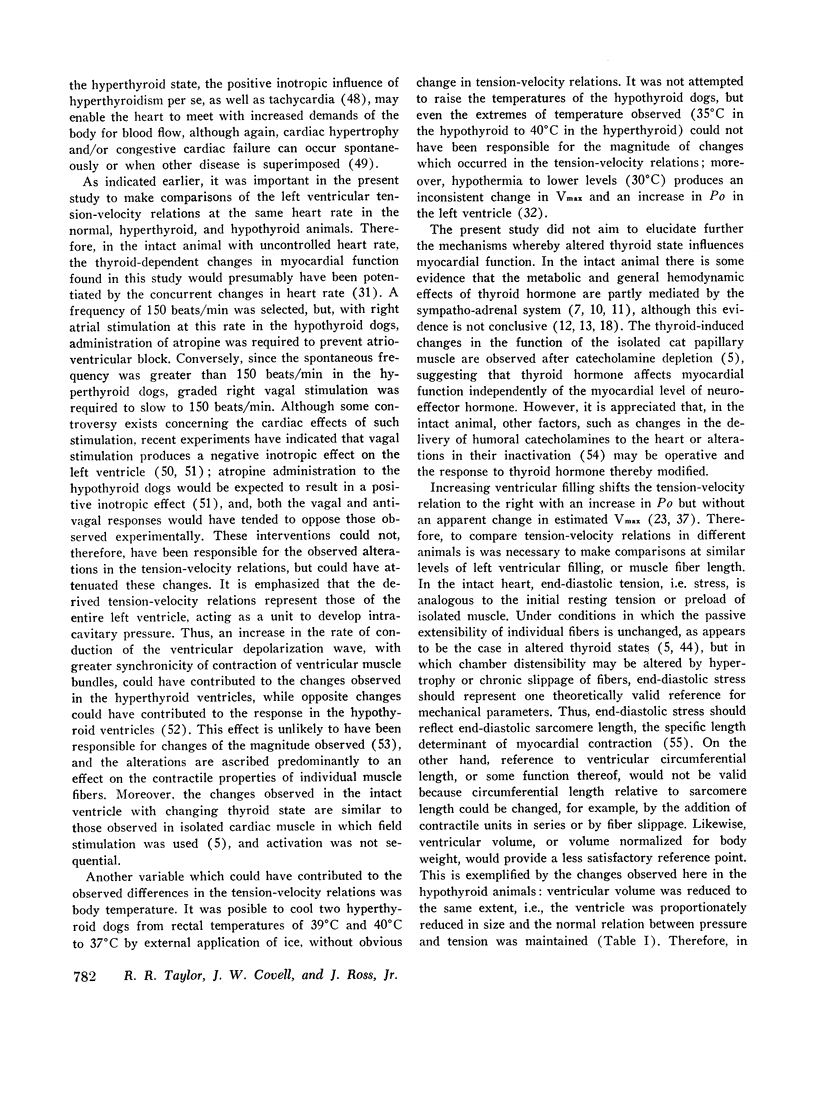
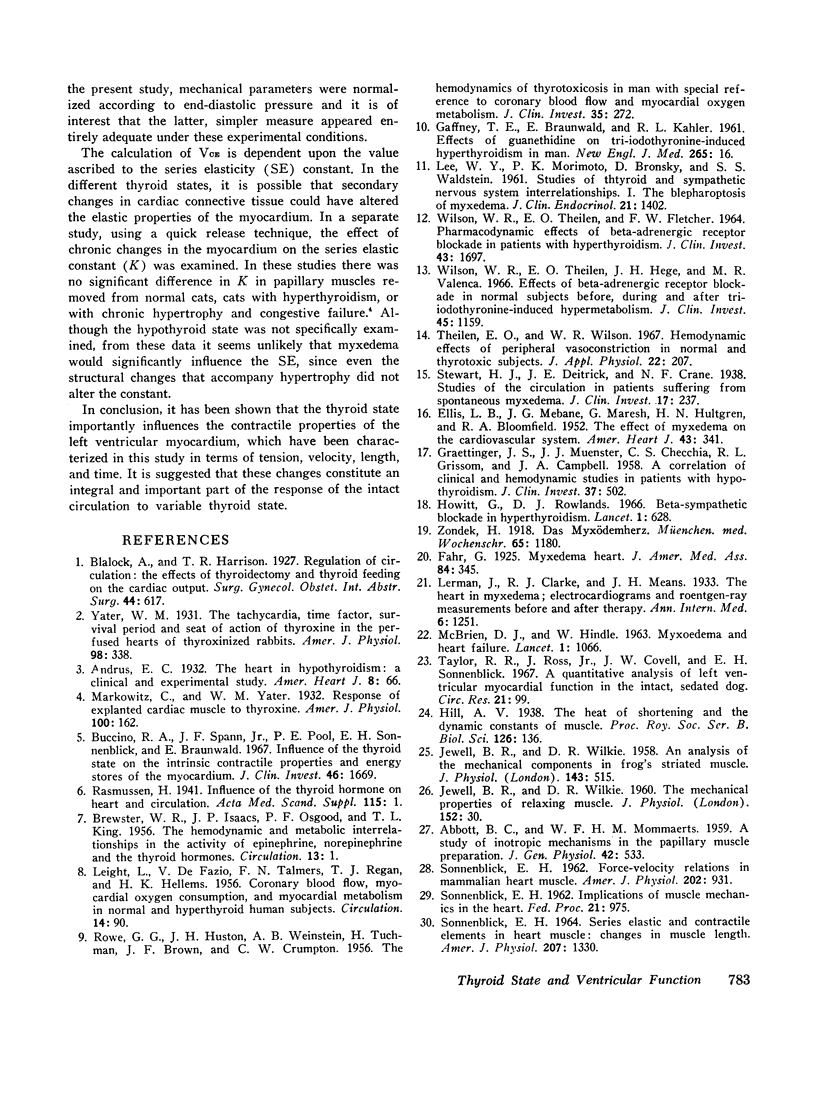
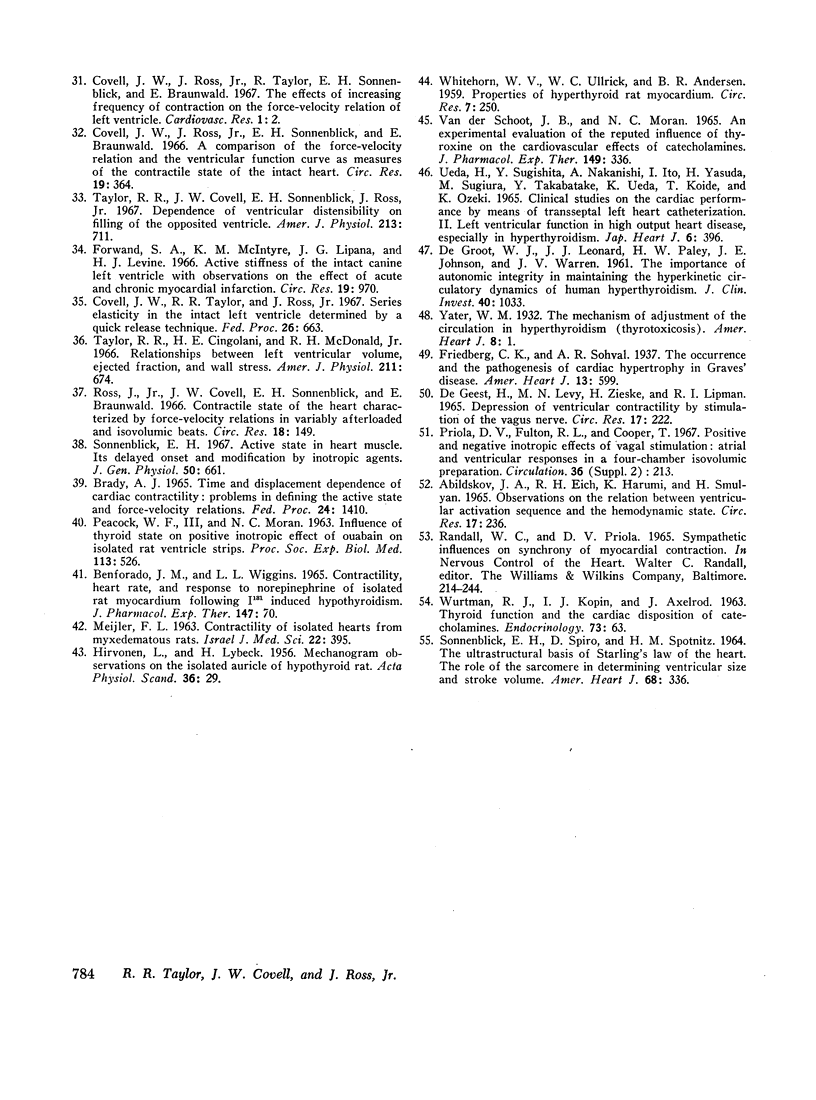
Images in this article
Selected References
These references are in PubMed. This may not be the complete list of references from this article.
- ABBOTT B. C., MOMMAERTS W. F. A study of inotropic mechanisms in the papillary muscle preparation. J Gen Physiol. 1959 Jan 20;42(3):533–551. doi: 10.1085/jgp.42.3.533. [DOI] [PMC free article] [PubMed] [Google Scholar]
- ABILDSKOV J. A., EICH R. H., HARUMI K., SMULYAN H. OBSERVATIONS ON THE RELATION BETWEEN VENTRICULAR ACTIVATION SEQUENCE AND THE HEMODYNAMIC STATE. Circ Res. 1965 Sep;17:236–247. doi: 10.1161/01.res.17.3.236. [DOI] [PubMed] [Google Scholar]
- BENFORADO J. M., WIGGINS L. L. CONTRACTILITY, HEART RATE, AND RESPONSE TO NOREPINEPHRINE OF ISOLATED RAT MYOCARDIUM FOLLOWING I-131-INDUCED HYPOTHYROIDISM. J Pharmacol Exp Ther. 1965 Jan;147:70–75. [PubMed] [Google Scholar]
- BREWSTER W. R., Jr, ISAACS J. P., OSGOOD P. F., KING T. L. The hemodynamic and metabolic interrelationships in the activity of epinephrine, norepinephrine and the thyroid hormones. Circulation. 1956 Jan;13(1):1–20. doi: 10.1161/01.cir.13.1.1. [DOI] [PubMed] [Google Scholar]
- Brady A. J. Time and displacement dependence of cardiac contractility: problems in defining the active state and force-velocity relations. Fed Proc. 1965 Nov-Dec;24(6):1410–1420. [PubMed] [Google Scholar]
- Buccino R. A., Spann J. F., Jr, Pool P. E., Sonnenblick E. H., Braunwald E. Influence of the thyroid state on the intrinsic contractile properties and energy stores of the myocardium. J Clin Invest. 1967 Oct;46(10):1669–1682. doi: 10.1172/JCI105658. [DOI] [PMC free article] [PubMed] [Google Scholar]
- Covell J. W., Ross J., Jr, Sonnenblick E. H., Braunwald E. Comparison of the force-velocity relation and the ventricular function curve as measures of the contractile state of the intact heart. Circ Res. 1966 Aug;19(2):364–372. doi: 10.1161/01.res.19.2.364. [DOI] [PubMed] [Google Scholar]
- Covell J. W., Ross J., Jr, Taylor R., Sonnenblick E. H., Braunwald E. Effects of increasing frequency of contraction on the force velocity relation of left ventricle. Cardiovasc Res. 1967 Jan;1(1):2–8. doi: 10.1093/cvr/1.1.2. [DOI] [PubMed] [Google Scholar]
- DEFAZIO V., HELLEMS H. K., LEIGHT L., REGAN T. J., TALMERS F. N. Coronary blood flow, myocardial oxygen consumption, and myocardial metabolism in normal and hyperthyroid human subjects. Circulation. 1956 Jul;14(1):90–99. doi: 10.1161/01.cir.14.1.90. [DOI] [PubMed] [Google Scholar]
- DEGEEST H., LEVY M. N., ZIESKE H., LIPMAN R. I. DEPRESSION OF VENTRICULAR CONTRACTILITY BY STIMULATION OF THE VAGUS NERVES. Circ Res. 1965 Sep;17:222–235. doi: 10.1161/01.res.17.3.222. [DOI] [PubMed] [Google Scholar]
- ELLIS L. B., MEBANE J. G., MARESH G., HULTGREN H. N., BLOOMFIELD R. A. The effect of myxedema on the cardiovascular system. Am Heart J. 1952 Mar;43(3):341–356. doi: 10.1016/0002-8703(52)90080-x. [DOI] [PubMed] [Google Scholar]
- Forwand S. A., McIntyre K. M., Lipana J. G., Levine H. J. Active stiffness of the intact canine left ventricle. With observations on the effect of acute and chronic myocardial infarction. Circ Res. 1966 Nov;19(5):970–979. doi: 10.1161/01.res.19.5.970. [DOI] [PubMed] [Google Scholar]
- GAFFNEY T. E., BRAUNWALD E., KAHLER R. L. Effects of guanethidine on tri-iodothyronine-induced hyperthyroidism in man. N Engl J Med. 1961 Jul 6;265:16–20. doi: 10.1056/NEJM196107062650104. [DOI] [PubMed] [Google Scholar]
- GRAETTINGER J. S., MUENSTER J. J., CHECCHIA C. S., GRISSOM R. L., CAMPBELL J. A. A correlation of clinical and hemodynamic studies in patients with hypothyroidism. J Clin Invest. 1958 Apr;37(4):502–510. doi: 10.1172/JCI103631. [DOI] [PMC free article] [PubMed] [Google Scholar]
- HIRVONEN L., LYBECK H. Mechanogram observations on the isolated auricle of hypothyroid rat. Acta Physiol Scand. 1956 Mar 24;36(1-2):29–37. doi: 10.1111/j.1748-1716.1956.tb01299.x. [DOI] [PubMed] [Google Scholar]
- Howitt G., Rowlands D. J. Beta-sympathetic blockade in hyperthyroidism. Lancet. 1966 Mar 19;1(7438):628–631. doi: 10.1016/s0140-6736(66)90825-7. [DOI] [PubMed] [Google Scholar]
- JEWELL B. R., WILKIE D. R. An analysis of the mechanical components in frog's striated muscle. J Physiol. 1958 Oct 31;143(3):515–540. doi: 10.1113/jphysiol.1958.sp006075. [DOI] [PMC free article] [PubMed] [Google Scholar]
- LEE W. Y., MORIMOTO P. K., BRONSKY D., WALDSTEIN S. S. Studies of thyroid and sympathetic nervous system interrelationships. I. The blepharoptosis of myxedema. J Clin Endocrinol Metab. 1961 Nov;21:1402–1412. doi: 10.1210/jcem-21-11-1402. [DOI] [PubMed] [Google Scholar]
- MEIJLER F. L. CONTRACTILITY OF ISOLATED HEARTS FROM MYXEDEMATOUS RATS. Isr Med J. 1963 Nov-Dec;22:395–404. [PubMed] [Google Scholar]
- PEACOCK W. F., 3rd, MORAN N. C. Influence of thyroid state on positive inotropic effect of ouabain on isolated rat ventricle strips. Proc Soc Exp Biol Med. 1963 Jul;113:526–530. doi: 10.3181/00379727-113-28417. [DOI] [PubMed] [Google Scholar]
- Parmley W. W., Spann J. F., Jr, Taylor R. R., Sonnenblick E. H. The series elasticity of cardiac muscle in hyperthyroidism, ventricular hypertrophy, and heart failure. Proc Soc Exp Biol Med. 1968 Feb;127(2):606–609. doi: 10.3181/00379727-127-32753. [DOI] [PubMed] [Google Scholar]
- ROWE G. G., HUSTON J. H., WEINSTEIN A. B., TUCHMAN H., BROWN J. F., CRUMPTON C. W. The hemodynamics of thyrotoxicosis in man with special reference to coronary blood flow and myocardial oxygen metabolism. J Clin Invest. 1956 Mar;35(3):272–276. doi: 10.1172/JCI103273. [DOI] [PMC free article] [PubMed] [Google Scholar]
- SONNENBLICK E. H. Force-velocity relations in mammalian heart muscle. Am J Physiol. 1962 May;202:931–939. doi: 10.1152/ajplegacy.1962.202.5.931. [DOI] [PubMed] [Google Scholar]
- SONNENBLICK E. H. Implications of muscle mechanics in the heart. Fed Proc. 1962 Nov-Dec;21:975–990. [PubMed] [Google Scholar]
- SONNENBLICK E. H. SERIES ELASTIC AND CONTRACTILE ELEMENTS IN HEART MUSCLE: CHANGES IN MUSCLE LENGTH. Am J Physiol. 1964 Dec;207:1330–1338. doi: 10.1152/ajplegacy.1964.207.6.1330. [DOI] [PubMed] [Google Scholar]
- SONNENBLICK E. H., SPIRO D., SPOTNITZ H. M. THE ULTRASTRUCTURAL BASIS OF STARLING'S LAW OF THE HEART. THE ROLE OF THE SARCOMERE IN DETERMINING VENTRICULAR SIZE AND STROKE VOLUME. Am Heart J. 1964 Sep;68:336–346. doi: 10.1016/0002-8703(64)90301-1. [DOI] [PubMed] [Google Scholar]
- Sonnenblick E. H. Active state in heart muscle. Its delayed onset and modification by inotropic agents. J Gen Physiol. 1967 Jan;50(3):661–676. doi: 10.1085/jgp.50.3.661. [DOI] [PMC free article] [PubMed] [Google Scholar]
- Stewart H. J., Deitrick J. E., Crane N. F. STUDIES OF THE CIRCULATION IN PATIENTS SUFFERING FROM SPONTANEOUS MYXEDEMA. J Clin Invest. 1938 May;17(3):237–248. doi: 10.1172/JCI100948. [DOI] [PMC free article] [PubMed] [Google Scholar]
- Taylor R. R., Cingolani H. E., McDonald R. H., Jr Relationships between left ventricular volume, ejected fraction, and wall stress. Am J Physiol. 1966 Sep;211(3):674–680. doi: 10.1152/ajplegacy.1966.211.3.674. [DOI] [PubMed] [Google Scholar]
- Taylor R. R., Covell J. W., Sonnenblick E. H., Ross J., Jr Dependence of ventricular distensibility on filling of the opposite ventricle. Am J Physiol. 1967 Sep;213(3):711–718. doi: 10.1152/ajplegacy.1967.213.3.711. [DOI] [PubMed] [Google Scholar]
- Taylor R. R., Ross J., Jr, Covell J. W., Sonnenblick E. H. A quantitative analysis of left ventricular myocardial function in the intact, sedated dog. Circ Res. 1967 Jul;21(1):99–115. doi: 10.1161/01.res.21.1.99. [DOI] [PubMed] [Google Scholar]
- Theilen E. O., Wilson W. R. Hemodynamic effects of peripheral vasoconstriction in normal and thyrotoxic subjects. J Appl Physiol. 1967 Feb;22(2):207–210. doi: 10.1152/jappl.1967.22.2.207. [DOI] [PubMed] [Google Scholar]
- Ueda H., Sugishita Y., Nakanishi A., Ito I., Yasuda H., Sugiura M., Takabatake Y., Ueda K., Koide T., Ozeki K. Clinical studies on the cardiac performance by means of transseptal left heart catheterization. II. Left ventricular function in high output heart diseases, especially in hyperthyroidism. Jpn Heart J. 1965 Sep;6(5):396–406. doi: 10.1536/ihj.6.396. [DOI] [PubMed] [Google Scholar]
- WHITEHORN W. V., ULLRICK W. C., ANDERSEN B. R. Properties of hyperthyroid rat myocardium. Circ Res. 1959 Mar;7(2):250–255. doi: 10.1161/01.res.7.2.250. [DOI] [PubMed] [Google Scholar]
- WILSON W. R., THEILEN E. O., FLETCHER F. W. PHARMACODYNAMIC EFFECTS OF BETA-ADRENERGIC RECEPTOR BLOCKADE IN PATIENTS WITH HYPERTHYROIDISM. J Clin Invest. 1964 Aug;43:1697–1703. doi: 10.1172/JCI105045. [DOI] [PMC free article] [PubMed] [Google Scholar]
- WURTMAN R. J., KOPIN I. J., AXELROD J. Thyroid function and the cardiac disposition of catecholamines. Endocrinology. 1963 Jul;73:63–74. doi: 10.1210/endo-73-1-63. [DOI] [PubMed] [Google Scholar]
- Wilson W. R., Theilen E. O., Hege J. H., Valenca M. R. Effects of beta-adrenergic receptor blockade in normal subjects before, during, and after triiodothyronine-induced hypermetabolism. J Clin Invest. 1966 Jul;45(7):1159–1169. doi: 10.1172/JCI105422. [DOI] [PMC free article] [PubMed] [Google Scholar]
- van der Schoot J. B., Moran N. C. An experimental evaluation of the reputed influence of thyroxine on the cardiovascular effects of catecholamines. J Pharmacol Exp Ther. 1965 Sep;149(3):336–345. [PubMed] [Google Scholar]



